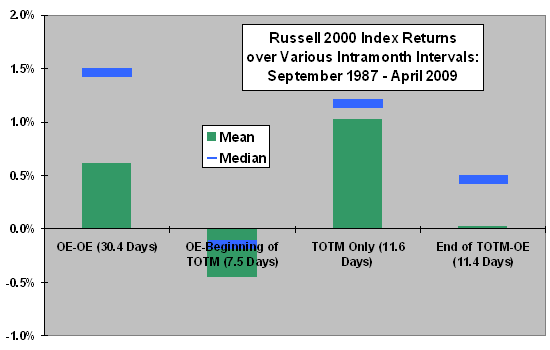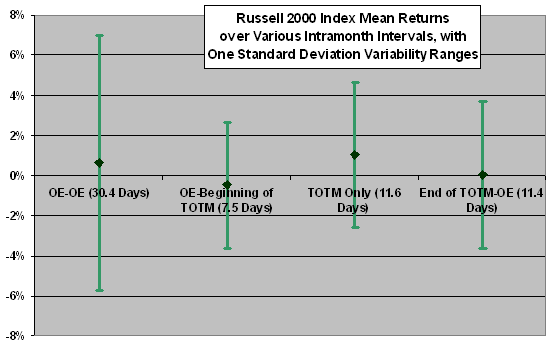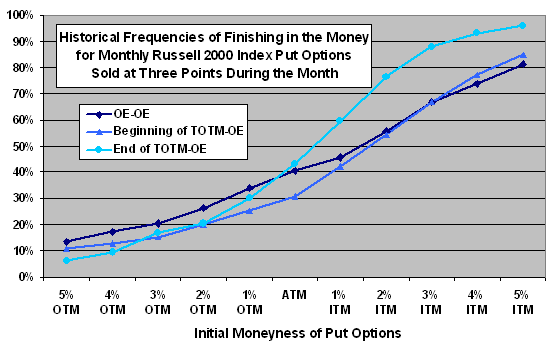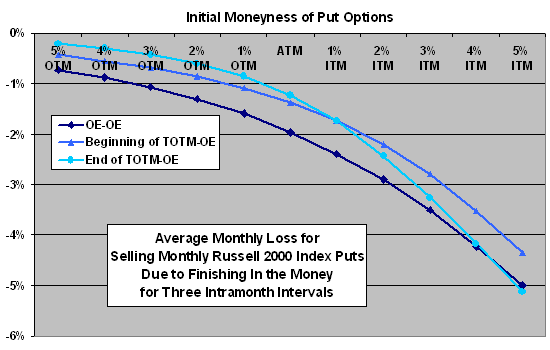The Strategy Test presently focuses on iteratively selling put options on the Russell 2000 Index with less than one month to expiration to capture the volatility risk premium. The test strategy seeks to exploit the turn-of-the-month (TOTM) effect to enhance this capture. Are there characteristics of index returns from options expiration (OE) to TOTM, during TOTM and from TOTM to OE that might inform options moneyness and position adjustment decisions? Using daily opening and closing levels of the Russell 2000 Index over the period September 1987 through April 2009 (259 complete months), we find that:
For the purpose of this analysis, we approximate:
- The OE level of the Russell 2000 Index is its value at the open on OE Friday.
- The level of the index at the beginning of TOTM is its value at the close on the fifth-to-last trading day of a calendar month.
- The level of the index at the end of TOTM is its value at the close on the fourth trading day of the next calendar month.
The following chart summarizes the mean and median monthly raw returns over the entire sample period for:
- The entire month, measured from OE to OE (an average 30.4 calendar days).
- The interval from OE to the beginning of the next TOTM (an average 7.5 calendar days).
- The TOTM interval (an average of 11.6 calendar days).
- The interval from the end of TOTM to the next OE (an average 11.4 calendar days).
The chart confirms the TOTM effect in that positive returns tend to concentrate during TOTM. In fact, the mean raw return from OE to the beginning of TOTM is negative, and the mean raw return from the end of TOTM to OE is close to zero. Median returns are higher than mean returns over all intervals because of the effects of a relatively few very large losses. However, even the median return is negative for the pre-TOTM interval.
Simple trend analysis suggests that the TOTM effect may have weakened a little over the sample period. Previous analysis (see our blog entry of 2/9/09) suggests that average TOTM returns are especially strong during advancing markets but are just roughly break-even during declining markets.

The next chart shows the same mean returns as the prior one, with one standard deviation variability ranges. In general, variability increases with the length of the measurement interval. The return distribution may not be amenable to further interpretation of the standard deviation.
What does the empirical variability say about the likelihood that a put option of given moneyness will expire in the money (resulting in a cash settlement debit)?

The next chart plots the frequency over the entire sample period with which put options with the nearest monthly expiration expire in the money for: (1) initial moneyness conditions ranging from 5% out of the money (OTM) to 5% in the money (ITM); and, (2) position opening times of the prior OE, the beginning of TOTM and the end of TOTM. With respect to suppressing in-the-money expirations over the entire sample period, it appears that the TOTM effect may be most helpful for at-the-money (ATM) put options.
Results are ideal in that exact moneyness states may not be available at the specified transaction times. Also, results may vary systematically during subperiods according to market trend and volatility state.
What is the effect of in-the-money expirations on average returns?

The final chart plots the average monthly loss due to in-the-money expirations over the entire sample period from selling put options with the nearest monthly expiration and holding to expiration. As for the differences between mean and median returns in the first chart, a relatively few large losses drive these results.
To achieve average profitability, the average option selling price for a given moneyness must exceed the average loss, after transaction costs. Cumulative profitability is likely path dependent.
As noted for the previous chart, results are ideal in that exact moneyness states may not be available at the specified transaction times. Also, these results may vary systematically for subperiods according to market trend and volatility state (as may the volatility risk premium).

In summary, simple analyses suggest that the TOTM effect may help reduce the loss frequency and average in-the-money expiration loss for selling index put options.